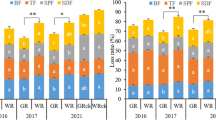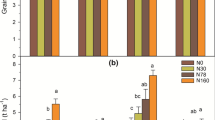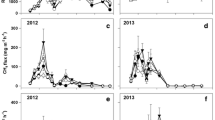Abstract
Rice alternated with upland crops has become increasingly popular in recent years. To investigate the residual effects of nitrogen from the previous upland crop on rice growth, two cropping systems, garlic-rice and wheat-rice, were studied from 2014 to 2017 under field conditions and from 2016 to 2017 under pot conditions. The results showed that the total nitrogen content in the 0–0.2 m soil was higher for the garlic-rice cropping system than for the wheat-rice cropping system and the 15N isotope abundance of the soil after harvesting garlic was 63% higher than that after harvesting wheat. Residual nitrogen from the preceding crops was one of the main nitrogen sources for rice growth. The contribution of residual nitrogen accounted for 17% to 60% of the total nitrogen accumulation by rice plants during the vegetative stage, which gradually decreased after the rice jointing stage. Most of the residual nitrogen absorbed by rice plants was transported to the reproductive organs for grain growth. Therefore, the growth of vegetative organs, viz., tillers and leaves, was more vigorous under the garlic-rice cropping system than under the wheat-rice cropping system. This led to a significant increase in total nitrogen accumulation in rice plants and an increase in rice yield by 8% to 16%, even under identical management of rice under upland crop–paddy rice systems. Thus, under upland crop–paddy rice systems, high-yield and high-efficiency rice production can be achieved by utilizing residual nitrogen from the preceding crops and decreasing the application of base and tiller nitrogen.





Similar content being viewed by others
Data availability
All data generated or analyzed during this study are included in this published article.
References
Ahmad N, Ahmad Z, Muhammda J, Akhtar A (2016) Bridging the yield gap in rice production by using leaf color chart for nitrogen management. J Botany. https://doi.org/10.1155/2016/2728391
Alberto MCR, Quilty JR, Buresh RJ et al (2014) Actual evapotranspiration and dual crop coefficients for dry-seeded rice and hybrid maize grown with overhead sprinkler irrigation. Agric Water Manag 136:1–12
Azam F, Muller C, Weiske A et al (2002) Nitrification and denitrification as sources of atmospheric nitrous oxide-role of oxidizable carbon and applied nitrogen. Biol Fertil Soils 35:54–61
Bao SD (2000) Soil agrochemical analysis. China Agricultural Press, Beijing
Beeman K, Arulmozhiselvan K (2017) Fate of 15N labeled nitrogen in maize grown with nutriseed pack using tracer technique. IJAEB 10:39–44
Deng F, Wang L, Ren W et al (2014) Enhancing nitrogen utilization and soil nitrogen balance in paddy fields by optimizing nitrogen management and using polyaspartic acid urea. Field Crop Res 169:30–38
Dobermann A, Witt C, Dawe D et al (2002) Site-specific nutrient management for intensive rice cropping systems in Asia. Field Crop Res 74:37–66
Du XN, Song MM, Zhao C (2009) Treatment methods of isotope 15N labeled sample for mass spectrometry. Atom. Energy Sci Technol 43(1):59–63 (in Chinese with English abstract)
He Y, Lehndorff E, Amelung W et al (2017) Drainage and leaching losses of nitrogen and dissolved organic carbon after introducing maize into a continuous paddy-rice crop rotation. Agri Ecosyst Environ 249:91–100
Heffer P (2009) Assessment of fertilizer use by crop at the global level 2006/07–2007/08. IFA, Paris
Hou HQ, Huang YL, Ji JH et al (2016) Effects of controlled-release fertilizer application on double cropping rice yield and nitrogen use efficiency. Chin J Rice Sci 30(4):389–396 (in Chinese with English abstract)
Jenkinson DS, Fox RH, Rayner JH (1985) Interactions between fertilizer nitrogen and soil nitrogen-the so-called ‘priming’ effect. J. Siol Sci 36:425–444
Jia D, Lu JJ, Sun YJ et al (2016) Effect of different nitrogen fertilizer application strategies on rice growth and yield. ASAR 8(1):33–39
Kadiyala MDM, Mylavarapu RS, Li YC et al (2015) Uptake efficiency of 15 N-urea in flooded and aerobic rice fields under semi-arid conditions. Paddy Water Environ 13:545–556
Ling QH, Zhang HC, Su ZF et al (1994) Leaf age model of rice. Science Press, Beijing
Linh TB, Sleutel S, Guong VT et al (2015) Deeper tillage and root growth in annual rice-upland cropping systems result in improved rice yield and economic profit relative to rice monoculture. Soil Till Res 154:44–52
Linh TB, Guong VT, Tran VTT et al (2017) Effects of crop rotation on properties of a Vietnam clay soil under rice-based cropping system in small-scale farmers’ fields. Soil Res 55:162–171
Liu Y, Ding YF, Wang QS et al (2011) Effects of nitrogen and 6-benzylaminopurine on rice tiller bud growth and changes in endogenous hormones and nitrogen. Corp Sci 51:786–792
Ni YJ, He QL, Li JP et al (2015) Effects of different irrigation times and nitrogen fertilizer application on leaf area index and grain yield of ‘Yujiao 5’. Agric Sci Technol 16(9):1969–1977
Pan S, Huang S, Zhai J et al (2012) Effects of N management on yield and N uptake of rice in central China. J Integr Agric 11(12):1993–2000
Patil MD, Das BS, Barak E et al (2010) Performance of polymer-coated urea in transplanted rice: effect of mixing ratio and water input on nitrogen use efficiency. Paddy Water Environ 8:189–198
Richard N, Trenton R, Nathan S et al (2013) Nitrogen uptake efficiency of a hybrid compared with a conventional, pure-line rice cultivar. Soil Sci Soc Am J 77:1235–1240
Shi CL, Zhu Y, Cao WX (2006) A simulation analysis on geometrical parameters of rice leaf blade. Sci Agric Sin 39(5):910–915
Timsima J, Jat ML, Majumdar K (2010) Rice-maize systems of south Asia: current status, future prospects and research priorities for nutrient management. Plant Soil 335:65–82
Zhang Q, Yang Z, Zhang H et al (2012) Recovery efficiency and loss of 15N-labelled urea in a rice-soil system in the upper reaches of the Yellow River basin. Agric Ecosyst Environ 158:118–123
Zhang T, Chen A, Liu J et al (2017) Cropping systems affect paddy soil organic carbon and total nitrogen stocks (in rice-garlic and rice-fava systems) in temperate region of southern China. Sci Total Environ 609:1640–1649
Zhao X, Yan X, Xie Y et al (2016) Use of nitrogen isotope to determine fertilizer- and soil-derived ammonia volatilization in a rice/wheat rotation system. J Agric Food Chem 64:3017–3024
Zhou W, Lv TF, Chen Y et al (2014) Soil physicochemical and biological properties of paddy-upland rotation: a review. Sci World J. https://doi.org/10.1155/2014/856352
Zhou W, Lv T, Zhang P et al (2016a) Regular nitrogen application increases nitrogen utilization efficiency and grain yield in Indica hybrid rice. Agron J 108(5):1951–1961
Zhou W, Lyu TF, Yang ZP et al (2016b) Research advances on regulation soil nitrogen loss by the type of nitrogen fertilizer and its application strategy. Chin J Appl Ecol 27(9):3051–3058
Zhou W, Yang Z, Wang T et al (2019) Environmental compensation effect and synergistic mechanism of optimized nitrogen management increasing nitrogen use efficiency in indica hybrid rice. Front Plant Sci. https://doi.org/10.3389/fpls.2019.00245
Zhu ZL (1985) Progress in the study of soil nitrogen supply and fate of fertilizer nitrogen in China. Soil 17(1):2–9
Acknowledgements
The authors would like to gratefully thank all the members of the Paddy Laboratory of Sichuan Agriculture University of China for their suggestions and help. We would like to thank Editage [www.editage.cn] for English language editing.
Funding
This study was funded by National Natural Science Foundation of China (NSFC) [Grant Number 31871564], Ministry of Science and Technology of the People’s Republic of China [Grant Numbers 2018YFD0301204, 2017YFD0301702], and Department of Science and Technology of Sichuan Province [Grant Number 2016NYZ0051].
Author information
Authors and Affiliations
Contributions
All authors contributed to the material preparation and data collection. WZ, YC, and WR contributed to the study conception and design. The first draft of the manuscript was written by WZ, and all authors contributed in the revised version of the manuscript. NM was responsible for language modification. All authors read and approved the final manuscript.
Corresponding author
Ethics declarations
Conflict of interest
The authors declare that they have no conflict of interest.
Ethical approval
This study did not involve any endangered or protected species; there were not any specific permits required for the described study and the landowner permitted this study to be carried out.
Consent to participate
There was not any specific participate consent for the described study.
Consent for publication
All contributors to this study agree to the publication of this study.
Additional information
Publisher's Note
Springer Nature remains neutral with regard to jurisdictional claims in published maps and institutional affiliations.
Rights and permissions
About this article
Cite this article
Zhou, W., Wang, T., Fu, Y. et al. Residual nitrogen from preceding garlic crops is important for double-cropped rice. Nutr Cycl Agroecosyst 118, 311–324 (2020). https://doi.org/10.1007/s10705-020-10099-1
Received:
Accepted:
Published:
Issue Date:
DOI: https://doi.org/10.1007/s10705-020-10099-1




